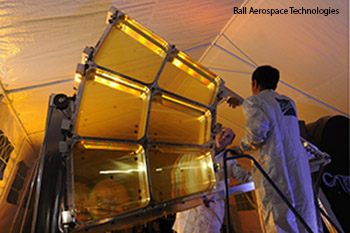
A one-eighth panel of a 5-meter-diameter membranous telescope designed for DARPA’s MOIRE program.
Ball Aerospace Technologies (Boulder, Colo., U.S.A.) announced the successful construction and testing of an important milestone in the Membrane Optical Imager for Real-Time Exploitation (MOIRE) program. The goal of the MOIRE program, a technology demonstration for the U.S. Defense Advanced Research Projects Agency (DARPA), is to provide space-based imaging data for the military in real-time using very large-aperture, lightweight telescopes in geosynchronous orbit 36,000 km up. Whereas current aircraft-based imaging technology is limited in its time-to-deployment and in its location, space-based telescopes could image any place on Earth in real-time.
The MOIRE telescope design incorporates advanced diffractive membrane optics on a 5-meter-diameter dish, which makes it nearly an order of magnitude lighter in mass than conventional optics. Launch costs would therefore be reduced by the same amount. Ball’s successful test involved a one-eighth segment of the dish, covered in a transparent membrane less than 1/1000th of an inch thick etched with a diffraction pattern.
Rob Strain, president of Ball, said, “The ground demonstration substantiates that this innovative technology could work on next-generation space telescopes to greatly reduce their costs and enable larger telescopes. This technology could apply to a wide-range of applications providing various forms of information to a multitude of users.”
The MOIRE telescope also uses secondary diffractive optical elements for the correction of chromatic dispersion. The project makes use of laser metrology and active optics to align the primary and secondary optics as well.
Phase 1 of the MOIRE project was completed in 2011. The current Phase 2 project seeks to reduce the risk involved in space-based imaging systems with diffractive optics. Once the primary optic and secondary optics proof-of-concept are complete, Phase 2 will also involve an on-orbit demonstration using the United States Air Force Academy’s FalconSAT-7 program.
